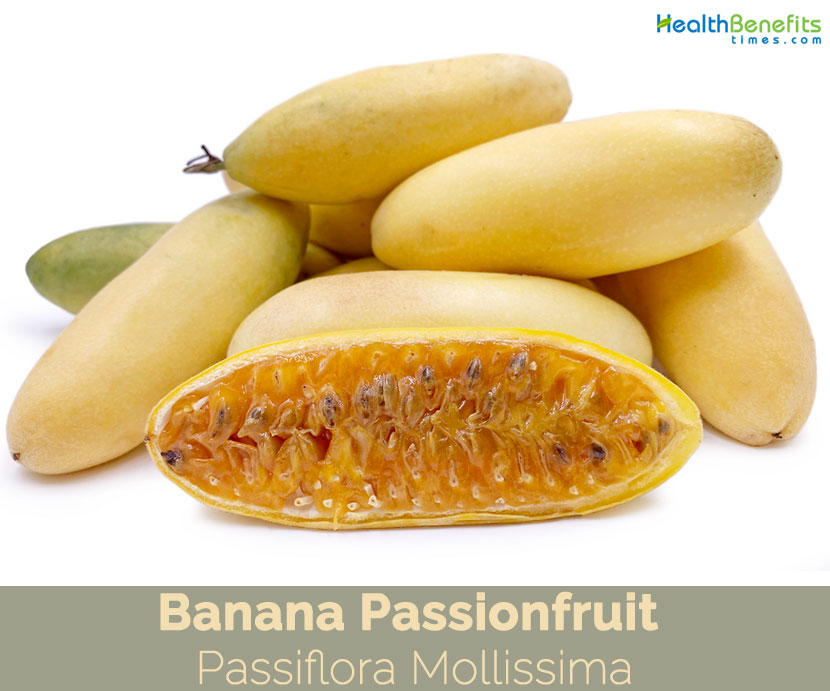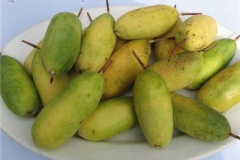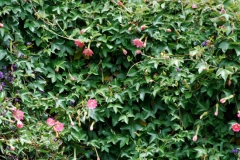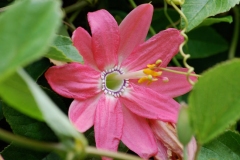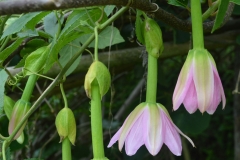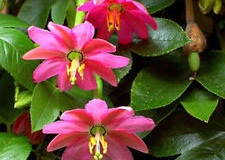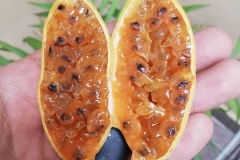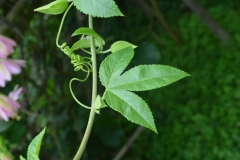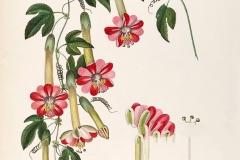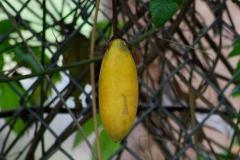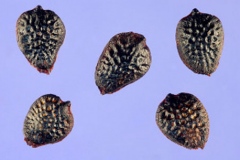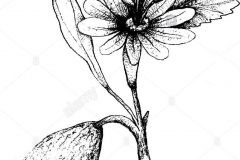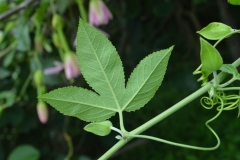The common name refers to the yellow, elongate shape of the mature fruit, superficially somewhat resembling a banana. “Poka” is a Hawaiian word with the connotation “to climb.” Banana poka is an aggressive vine that is rapidly invading mid- to upper elevation native forests. It covers smothers and breaks underlying vegetation with dense mats of stems and foliage. Resource managers of natural areas, such as those of Hawaii’s national parks, consider banana poka one of the highest priority forest weed species for bio control. There are two species of banana passion fruit, both very similar in appearance, and they have the scientific name Passiflora tarminiana and Passiflora tripartita var. mollissima, and they are from the family Passifloraceae, the family of passion fruit and other flowering plants.
Plant Description
Banana Passion fruit is a vigorous climbing, semi woody, perennial liana that grows up to 20 – 23 ft. (6-7 m) tall. The plant is found growing in watercourses, riparian areas, closed forests, forest margins, open woodlands, waste areas, hedges, trees, roadsides, buffer zones, plantation crops in temperate and occasionally also sub-tropical regions. Roots are shallow with 70% of the roots in the first 30 cm of soil. Stems are cylindrical and coated with yellow hairs. Like most of its relatives tendrils are borne in the leaf forks.
Leaves
Alternately arranged leaves are 6-16 cm long, 7-20 cm wide, deeply 3-lobed, moderately to densely pubescent, grayish or yellowish-velvety on the underside and downy above, with clearly defined veins. They have toothed margins and the lobes are pointed. Their upper surfaces are hairless or almost hairless. Petioles are with 6-14 glands, stipules are obliquely ovate, 6-20 mm long by 12-30 mm wide, persistent.
Flowers
The large pale pink flowers are about 6 cm across and 9-10 cm long and are borne singly in the leaf forks on stalks that are 3-10 cm long. Flowers hang downwards and at the base of the each flower are pair of bracts that is 3-4 cm long and 2-3 cm wide that can be mistaken for sepals. Five sepals and five petals are all very similar in size about 4.5-6 cm long and 1.2-2.5 cm wide and color. Their bases are joined together, forming a very long and narrow greenish-colored floral tube 6-8 cm long and 7-10 mm wide. Each flower also has five stamens and a hairy ovary topped with three white styles ending in green stigmas. Flowering can occur throughout the year.
Fruit
The fruit of P. tripartita var. mollissima is an oblong or oblong-ovoid berry 5-12 cm long and 3-4 cm wide that has a soft but thick and protecting leathery that turns from green to yellow or pale orange in color as it matures, covered by a fine pubescence. The epicarp is hard but flexible and the mesocarp very thin. The salmon-colored pulp, making up 60% of the fruit weight, contains small, black, flat, elliptic seeds that are surrounded by a sometimes almost sweet; other times fairly sour aril, with a typical fine and special aroma. The common name refers to the yellow (when ripe) oblong-shaped fruit superficially resembling a banana.
History
Banana passion fruit are native to the tropical and subtropical Andean regions of South America, including Venezuela, Bolivia, Peru, and eastern Colombia. Banana passion fruit were introduced to the United States in 1920, when the Department of Agriculture received seeds from Ecuador and Colombia. They are not commonly grown in the United States today but are found in most tropical regions of the world, including in the Mediterranean, Africa, Australia and India.
- It is a good herbal remedy for headache.
- It is a good herbal treatment for brain disorder like, hysteria and epilepsy.
- Tea prepared from passion fruit helps in treating Insomnia (Sleeplessness).
- Fruit has high amount of Vitamin A that is important for good Eyesight.
- It is a good herbal remedy for hay fever.
- Passion fruit tea is a good herbal remedy for anxiety.
- Fruit extract is good for fighting Lung and Mouth Cancer.
- Fruit juice is helpful in combating Digestive Problems (Stomach Ache, Vomiting, etc.), gastric problems (Anorexia, Flatulence, etc.) and has a relaxing effect.
- Fruit is a good herbal remedy for countering heart attacks. The fruit helps in controlling Heart Rate.
- Potassium present in the fruit controls blood pressure. The Passion Fruit is a good herbal treatment for maintaining blood pressure.
- Polyphenols present in the fruit seeds relaxes the Blood Vessels.
- Passion Fruit is rich in Piceatannol and Scirpusin B content that helps in maintaining the Immune System and protects the body from free radical formation.
- Passion fruit cures Anemia.
- It is a good herbal remedy for the Skin. It halts premature aging.
- Its fruit is a good herbal treatment for respiratory ailments like wheezing and cough.
- It also helps in combating the problem of asthma.
- Magnesium present in the fruit is good for the Bones.
- Fruit contains dietary fibers, which helps in removing cholesterol from the body. Since, it reduces Cholesterol it aids in weight Loss.
- It helps to regulate Bowel Movement and stops Bowel Problem as well as Hemorrhoids.
- Its leaves are used in the treatment of menopause symptoms.
https://www.youtube.com/watch?v=wnOhMpKXDec
Culinary Uses
- Fruit are eaten raw or used in ice creams, fruit salads, pies, jellies, to make drinks etc.
- Pulp is eaten out-of-hand or is strained for its juice which is not consumed alone but used in refreshing mixed cold beverages.
- Yellow, oblong, aromatic fruits are highly prized for their juice.
- Fruits of this species are a pale yellow color; the pulp is more aromatic and tart and has a somewhat superior flavor to the flesh of the deep yellow to orange fruits of Passiflora tarminiana.
- Juice can be made in a blender mixing it with water or milk and sugar, and straining out the seeds.
- It is also used in gelatin desserts.
- In Ecuador, ice cream is made with the pulp.
- It is also used to prepare drinks as a replacement of the lemon or lime flavors.
- In Bolivia, the juice is combined with aguardiente and sugar, and served as a pre-dinner cocktail.
- It is also supported as an ingredient in fruit salad, particularly with pineapple, and for blending with whipped cream as a pudding, and for cooking and preserving as an ice-cream topping.
- Banana passion fruit may be used in desserts such as cakes and pies, or in relishes, jams and other preserves.
- It pairs well with other tropical fruit like pineapples, kiwis, strawberries, mango, papaya, orange and guava in fruit salads.
- Banana passion fruit pairs well with fatty, creamy foods like cheesecake, cream sauces, duck breast, parfaits, and yogurt.
Different Control Methods
Physical control
Because stems of P. mollissima do not readily sprout, mechanical means of control may serve in selected areas. Some sprouting has occurred on the abaxial cut surface, however. Careful use of these techniques may be effective for control of small populations in the immediate future.
Chemical control
Since the 1970’s, several attempts by the State of Hawaii and the National Park Service at control by physical and chemical means have met with little success. The extent and density of infestations make these methods uneconomical as well as ineffective. However, one exception was noted where forests of the endemic Acacia koa are being re-established on degraded montane forest land infested by P. mollissima. The application of a high dose of glyphosate prior to planting Acacia significantly reduced the mortality of Acacia by P. mollissima after 10 years; in contrast, all Acacia trees were killed on untreated plots.
Biological control
Because of its widespread distribution and dense populations in many areas, some feel that overall control of P. mollissima in Hawai’i can only be achieved by using biological control. In the early 1970s, an alien passion vine butterfly, Agraulis vanillae, was introduced to Koke’e to control P. mollissima. Individuals did not readily establish on P. mollissima and were therefore unsuccessful in its control. The Division of Forestry then looked for biological control agents present in Hawai’i. Serious attempts at biological control began in 1981, when the Hawai’i State Legislature appropriated funds to begin control work on forest pest plants. P. mollissima is attacked by many pests and diseases in its native range but at present only one candidate, a moth, Cyanotricha necyrina, has been cleared by officials for release. Studies on the potential of Fusarium oxysporum f. passiflorae are in progress. High host specificity is needed due to the large commercial passion fruit industry on Hawai’i and the potential damage which might be caused to this by more generalist control agents.
Cultural control
Natural areas not yet infested with P. mollissima could be fenced to prevent ingress of P. mollissima through pig dispersal.
Other Facts
- A single vine can produce 200 to 300 fruits.
- Attractive, deep pink blossoms of the Banana passion fruit plant are also grown for their ornamental qualities, while vines are used in landscaping to cover trellises.
- Each fruit produce an estimated 150 seeds.
References:
https://www.itis.gov/servlet/SingleRpt/SingleRpt?search_topic=TSN&search_value=896794#null
https://pfaf.org/user/Plant.aspx?LatinName=Passiflora+tripartita+mollissima
https://www.cabi.org/isc/datasheet/38802
https://plants.usda.gov/core/profile?symbol=PATRM
http://www.theplantlist.org/tpl1.1/record/kew-2560473
http://www.hear.org/Pier/pdf/pohreports/passiflora_mollissima.pdf
https://hort.purdue.edu/newcrop/morton/banana_passion_fruit.html
https://www.flowersofindia.net/catalog/slides/Banana%20Passion%20Flower.html
https://gd.eppo.int/taxon/PAQMO
https://en.wikipedia.org/wiki/Banana_passionfruit
Comments
| Banana Passionfruit Quick Facts | |
|---|---|
| Name: | Banana Passionfruit |
| Scientific Name: | Passiflora Mollissima |
| Origin | Andes of South America, including eastern Cordillera of the Andes of Colombia, southeastern Andean slopes of Peru and western slopes of the Bolivian and Venezuelan Andes |
| Colors | Green turning to bright yellow or orange-yellow as the fruit ripens |
| Shapes | Oblong or oblong-ovoid, 2 to 4 3/4 in (5-12 cm) long, 1 1/4 to 1 1/2 in (3.2-4 cm) wide |
| Flesh colors | Salmon-colored |
| Taste | Very tasty, sweet |
| Health benefits | Beneficial for headache, hysteria, epilepsy, Insomnia, hay fever, Lung and Mouth Cancer, digestive Problems, blood pressure, asthma, Hemorrhoids and weight Loss |
| Name | Banana Passionfruit |
|---|---|
| Scientific Name | Passiflora Mollissima |
| Native | Andes of South America, including eastern Cordillera of the Andes of Colombia, southeastern Andean slopes of Peru and western slopes of the Bolivian and Venezuelan Andes |
| Common Names | Banana passion fruit, Softleaf passion flower, Sweet calabash, Banana passionflower, Banana poka, Bananadilla, Curuba sabanero blanco, curuba, tintin, tumbo, trompos, granadilla cimarrona, banana passion flower, banana passion vine, passion-flower vine, pink banana passionfruit |
| Name in Other Languages | Colombia: Curuba de Castilla Ecuador: Tacso de Castilla English: Banana passion fruit, Softleaf passion flower, Sweet calabash, Banana passionflower, Banana poka, Bananadilla, Curuba sabanero blanco, curuja, tasco, Finnish: Venezuelanpassio French: Tacso, fleur de la passion banana, passiflore molle, tacsonia German: Passionsfrucht-Art, Weichste Passionsblume, Bananen-Passionsblume, Curuba Portuguese: Maracujá-banana Russian: Bananovaya hranadylla (банановая гранадилла), passiflora nezhneyshaya (пассифлора нежнейшая), strastotsvet myagchayshiy (страстоцвет мягчайший), тахо South Africa: Piesangdilla | Spanish: Curuba, Curuba de Castilla, Curuba sananera blanco, Parcha, Tacso, Tacso de Castilla, Tagso, Tumbo, Tumbo del norte, bananadilla, curuba castillana, tintin, trompos, granadilla cimarrona |
| Plant Growth Habit | Vigorous climbing, semi woody, perennial liana |
| Growing Climates | Watercourses, riparian areas, closed forests, forest margins, open woodlands, waste areas, hedges, trees, roadsides, buffer zones, plantation crops in temperate and occasionally also sub-tropical regions |
| Plant Size | Up to 20 – 23 ft (6-7 m) |
| Root | Shallow with 70% of the roots in the first 30 cm of soil |
| Stem | Cylindrical and coated with yellow hairs. Like most of its relatives it has tendrils |
| Leaf | Deeply 3-lobed leaves, 3 to 4 in (7.5-10 cm) long and 2 3/8 to 4 3/4 in (6-12 cm) wide, are finely toothed and downy above, grayish-or yellowish-velvety beneath. The stipules are short, slender and curved |
| Flower | Blossom has a tube 3 to 4 in (7.5-10 cm) long, gray-green, frequently blushed with red, rarely downy; corolla with 5 oblong sepals and deep-pink petals flaring to a width of 2 to 3 in (5-7.5 cm); and a rippled, tuberculated, purple corona |
| Fruit Shape and Size | Oblong or oblong-ovoid, 2 to 4 3/4 in (5-12 cm) long, 1 1/4 to 1 1/2 in (3.2-4 cm) wide |
| Fruit Color | Green turning to bright yellow or orange-yellow as the fruit ripens |
| Fruit Skin | Thick, leathery, whitish-yellow or, in one form, dark-green, and minutely downy |
| Flesh Color | Salmon-colored |
| Seed | Small, black, flat, elliptic, reticulated seeds |
| Propagation | By cuttings or seed |
| Taste | Very tasty, sweet |
| Plant Parts Used | Fruits |
| Lifespan | Exceed 20 years |
| Season | Late March or early April to September or October |


